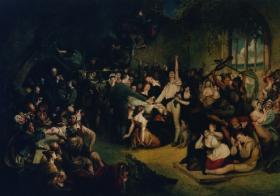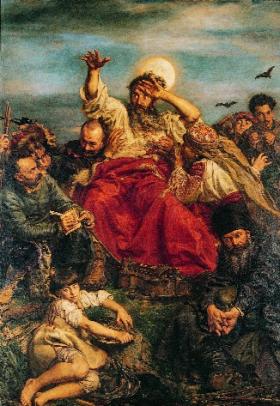Millennialism, Maclise and Matejko
Published in 18th–19th - Century History, Issue 6 (Nov/Dec 2007), News, Volume 15
Daniel Maclise, The Installation of Captain Rock, 1834. (Private collection)
In 1771 a ‘Signor Pastorini’ (actually the English bishop Charles Walmesley) asked: ‘How long, O Lord, do you defer judging our cause, you who are holy and must detest the cruelties exercised upon us; you, who are true and have told us, you will revenge the injuries done to your servants?’ He also declared that the Apocalypse of St John had foretold that the Protestant ‘locusts’ would all be swept away by about 1825. Pastorini’s Prophecies soon became a staple in the hedge-schools, especially after the famine and typhus epidemic of 1817. His insistence on Catholic revenge became inspirational for the violent ‘Rockite’ movements, despite opposition from the Catholic Church, led by Bishop Doyle, who saw the universalism of the Catholic Church as a cure for sectarian Irish nationalism. But the failure of the government to implement the promised Catholic emancipation after the Act of Union led to large numbers of Catholic servicemen and veterans of the Napoleonic Wars becoming involved in the increasing sectarianisation of Irish politics. The Connaught Journal of 17 January 1825 reported a plot within the 25th Regiment of Foot to massacre Protestants on New Year’s Day 1825, based on Pastorini’s Prophecies.
Little wonder, then, that when Daniel Maclise (1806–70) came to paint The Installation of Captain Rock in 1834 he included (on the left of the painting) a demagogic hedge-schoolmaster with a youth carrying his pile of books, most likely including Pastorini’s Prophecies. Thomas Moore’s Memoirs of Captain Rock (1824) served as the literary inspiration for Maclise’s painting, the ruined abbey echoing the narrator’s encounter with Captain Rock. Although Moore was more English Whig than Irish nationalist, Maclise’s politics appear to have been Tory, based on Romantic medievalism and his friendship with Disraeli. He was also part of the Cork circle in London contributing to the Tory Fraser’s Magazine, which included William Maginn and Francis Mahony (writing as ‘Father Prout’), whose work became a byword for whimsical complexity and ‘colonial eccentricity’.
This complexity is self-evident in Maclise’s work, breaking the conventions of history painting that demanded an intelligible single heroic moment from the past. This confused image perplexed nineteenth-century viewers, disturbed by its combination of violence and eroticism, and the gun aimed at the spectator only heightened this unease. Readers/viewers may become equally unsettled as they begin to imagine the likely content of the hedge-schoolmaster’s rant, especially if he is using Pastorini as his source. Moore’s Captain Rock himself supplies us with a probable text: ‘So late, however, as 1796 “all foreigners of all descriptions” (including, of course, Jews, Turks and other outlandish infidels) were invited not only to the benefits of naturalisation, but to the enjoyment of all those civil advantages, from which the native Catholic was then, and is now, excluded’ (Memoirs, pp 218–19).

Jan Matejko, Wernyhora, 1883–4. (National Museum, Krakow)
Also in 1771 the Ukrainian Cossack Wernyhora was making millennial prophecies that were to radically influence Polish nationalism. His prophecies were made during a period of intense communal violence, with Poles, Ukrainians and Jews massacring each other. He sought peace in a vision of a multinational ‘greater Poland’, proclaiming ‘Let us love one another for we are all children of the same mother, Poland, the mother of many nations’. Wernyhora’s prophecies were widely circulated during the November Rising of 1830 and the 1863 Rising; they were echoed in Pilsudski’s failed Federation of the Border Nations (1918–21) and persist as an emotional link in Polish support for the recent ‘Orange Revolution’ in Ukraine.
Unlike Pastorini, Wernyhora passed into high culture, particularly in Jan Matejko’s painting from 1883. Wernyhora is shown at the moment of inspiration, supported by a Ukrainian woman and a Cossack man, while a Ukrainian couple approaches from the right. On the left, the Polish noble Nikodem Suchodolski, starost of Korsun, records the prophecies, while behind him is an armed hajdamaka—a Lithuanian ‘marauder from the Wild Fields’. In the foreground at the left sits a peasant boy clutching an image of Our Lady of Czestochowa, while on the right is an Orthodox priest. Wernyhora himself is dressed like an Old Testament prophet, giving us the Jewish link, and the bats in the background provide a clue to his inspired status, the bat being a symbol of melancholic inspiration in the Renaissance—most famously in Durer’s Melancolia.
Jan Matejko (1838–93) became a cult figure for Polish nationalists through his history painting, which he saw as a ‘great mission dedicated to the nation in slavery’. Matejko’s brother was killed in the 1863 Rising, and he embarked on a series of major paintings showing Polish triumphs, promoting Wernyhora’s idea. His work was part of the ‘organic works’ movement, when intellectuals and artists abandoned physical force in favour of a Polish cultural renaissance. In 1878–9 Matejko made his first trip to Venice and became deeply influenced by Tintoretto and Veronese, especially in their sedate composition and use of rich colour, as seen in Wernyhora.
Matejko’s multi-talented pupil Stanilaw Wyspianski (1869–1907) took up the Wernyhora theme in his famous play Wesele (The Wedding) of 1901, which tried to revive the symbolic language used to talk about the Polish situation. With Wernyhora’s lost golden horn becoming symbolic of the lost hopes of Poland, Wesele has remained popular, especially since Andrzej Wajda’s 1973 film, while Michal Zadara’s 2006 production focused on nationalism’s need for an external enemy as a source of unity, and the problems ahead for the new Poland.
The capacity of Wernyhora as a symbolic figure to be reinvented is obviously related to the openness of his vision, going beyond sectarianism to embrace a form of intercultural nationalism. This also explains why Pastorini is no longer useful as a symbol in Irish politics, and further points to the failure of the nineteenth-century British establishment to realise that Gallican Catholicism could have been a cure for Irish nationalism, just as Wernyhora saw ‘Mother Poland’ as a cure for Polish sectarianism. One of the things needed for the transition to an intercultural Ireland is a symbolic language to represent this change. Perhaps we could join in the search for Wernyhora’s golden horn.
John Molloy is a lecturer in art history and critical theory at the Galway–Mayo Institute of Technology.


















